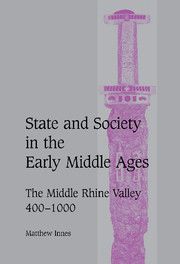Book contents
- Frontmatter
- Contents
- List of figures
- List of abbreviations
- A note on nomenclature and citations
- Acknowledgements
- Map 1 The Carolingian Rhineland
- Map 2 The Carolingian middle Rhine valley
- 1 INTRODUCTION
- 2 MONASTICISM, SPIRITUAL PATRONAGE AND SOCIAL STRUCTURE
- 3 LAND, KINSHIP AND STATUS
- 4 LOCAL POWER: COLLECTIVE ACTION, CONFLICT AND CONSENSUS
- 5 LOCALITY AND CENTRE: MECHANISMS OF EXTRACTION
- 6 POLITICAL POWER FROM THE FIFTH TO THE ELEVENTH CENTURY
- 7 CONCLUSION: STATE AND SOCIETY IN THE EARLY MEDIEVAL WEST
- List of primary sources
- Bibliography of secondary works
- Index
- Cambridge Studies in Medieval Life and Thought Fourth series
5 - LOCALITY AND CENTRE: MECHANISMS OF EXTRACTION
Published online by Cambridge University Press: 10 July 2009
- Frontmatter
- Contents
- List of figures
- List of abbreviations
- A note on nomenclature and citations
- Acknowledgements
- Map 1 The Carolingian Rhineland
- Map 2 The Carolingian middle Rhine valley
- 1 INTRODUCTION
- 2 MONASTICISM, SPIRITUAL PATRONAGE AND SOCIAL STRUCTURE
- 3 LAND, KINSHIP AND STATUS
- 4 LOCAL POWER: COLLECTIVE ACTION, CONFLICT AND CONSENSUS
- 5 LOCALITY AND CENTRE: MECHANISMS OF EXTRACTION
- 6 POLITICAL POWER FROM THE FIFTH TO THE ELEVENTH CENTURY
- 7 CONCLUSION: STATE AND SOCIETY IN THE EARLY MEDIEVAL WEST
- List of primary sources
- Bibliography of secondary works
- Index
- Cambridge Studies in Medieval Life and Thought Fourth series
Summary
APPROACHING EARLY MEDIEVAL GOVERNMENT
Carolingian kings wielded a formidable degree of structural power. They were able to maintain an efficient military machine and successfully extract the labour which enabled the building of palaces, fortifications, roads, bridges and other public works. For us, it is second nature to assume that structural power of this type must be based on a system of political organisation resembling the modern state: so begins a long search for administrative institutions. Yet, as we have seen, political power in Carolingian society did not rest on a dedicated state infrastructure of delegated official roles. If it is difficult for us to reconcile such a state of affairs with real structural power on the part of kings, that is an indication of our ingrained ‘statism’. To understand the foundations of the structural power enjoyed by Carolingian rulers, we need to start from the localities, and investigate the extent to which royal demands impinged on them, and the mechanisms through which these demands were met.
Uncovering these mechanisms is difficult: the primary interest of most of the surviving Carolingian documentation was not the day-to-day supply of palaces, messengers or soldiers. The problem facing any attempt to reconstruct rule from the bottom up is that whilst royal edicts can be made as general or specific as the reader wishes, the detailed local evidence – above all that of the polyptychs – inevitably concerns only ecclesiastical and fiscal property.
- Type
- Chapter
- Information
- State and Society in the Early Middle AgesThe Middle Rhine Valley, 400–1000, pp. 141 - 164Publisher: Cambridge University PressPrint publication year: 2000

